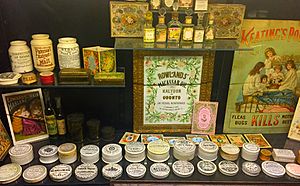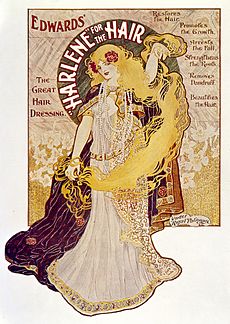Victorian-era cosmetics facts for kids
Victorian-era cosmetics were beauty products used by people during the Victorian age, which was a time when Queen Victoria ruled Great Britain (from 1837 to 1901). Unlike today's makeup, many Victorian cosmetics were quite dangerous. They often contained harmful ingredients like lead, mercury, arsenic, and ammonia.
During this time, having very pale skin was a sign of high social status. It meant a woman didn't have to work outdoors in the sun, showing she was wealthy. There were two main beauty styles: the "natural" look, which suggested good morals, and the "painted" look, which was seen as a bit daring or bold.
Contents
Skin Care and Complexion
In the Victorian era, a clear, natural face without any spots or freckles was considered truly beautiful. Even though women were expected to look naturally perfect, they often secretly made their own beauty remedies and cosmetics. They wanted to improve their features and hide any flaws. Since wearing makeup openly was not accepted, women kept their beauty routines private.
One of the most important beauty goals for Victorian women was to have the palest, most see-through skin possible. A light and healthy complexion showed a woman's social standing. Ladies from higher society would use things like gloves and umbrellas to protect their skin from the sun and weather.
Cold Cream: A Safe Choice
Cold cream, a mix of water, oil, a thickener, and an emulsifier, became a very important part of Victorian women's beauty routines. People believed cold cream was good for cleaning the skin and keeping it moisturized. It helped Victorian women keep their skin very soft and delicate. This cream was one of the few beauty products from that time that was quite safe to use and was not frowned upon. Cold cream has actually been around since ancient times!
The "Painted" Look
Women who chose the "painted" look used white paints and enamels on their faces and arms. If they used these, they had to avoid making big facial expressions because the makeup would crack. These substances were also very bad for the skin because they contained harmful ingredients like lead, mercury, and arsenic. Women often had to keep applying them to cover up the damage they caused.
Cheeks and Lips
Women used rouge to add color to their cheeks and lips. Even though wearing obvious makeup was discouraged, women found ways to make their complexion look better with a touch of color. Natural ingredients, like strawberries or herbs, were thought to give a nice, subtle color and were preferred. Lip rouge was made from many different things, including animal fat, beetroot, herbs, beetles, and almonds, to create a pink or red shade.
Eye Beauty
Having slightly watery eyes was seen as attractive because, along with pale skin, it was linked to a delicate appearance. To get this look, women would put drops of perfume, citrus juice, or a plant extract called belladonna into their eyes. Using belladonna for too long could cause serious harm to their eyes over time. Mercury was also used to make eyebrows and eyelashes look fuller.
Hair Styles and Care
High-society Victorian women aimed for a natural beauty look to appear pure and young. However, they still needed hair treatments and products to keep their fancy hairstyles in place. For many cultures, a woman's hair shows her femininity, and Victorian women felt the same way. Many old photographs from the 1800s show women with extremely long hair. The length of their hair, in particular, showed how healthy a woman was and how well she took care of herself. Both men and women used products to help their hair grow. Since women were limited in how much makeup they could wear, their hair was always kept very neat. Victorian women would braid their hair, use hair wigs, and apply heat to make tight curls. The Victorian era was a time when it became easier for people to focus on personal cleanliness than in earlier generations.
Perfume
Queen Victoria believed that floral scents were the most suitable for women to wear. Perfumes often used flowers like lavender, violet, and rose—with violet being very popular. They also used citrus scents and sometimes added herbs like rosemary to make the smell even better. Perfume was usually sprayed on clothing, hair, and handkerchiefs, rather than directly on the skin.



